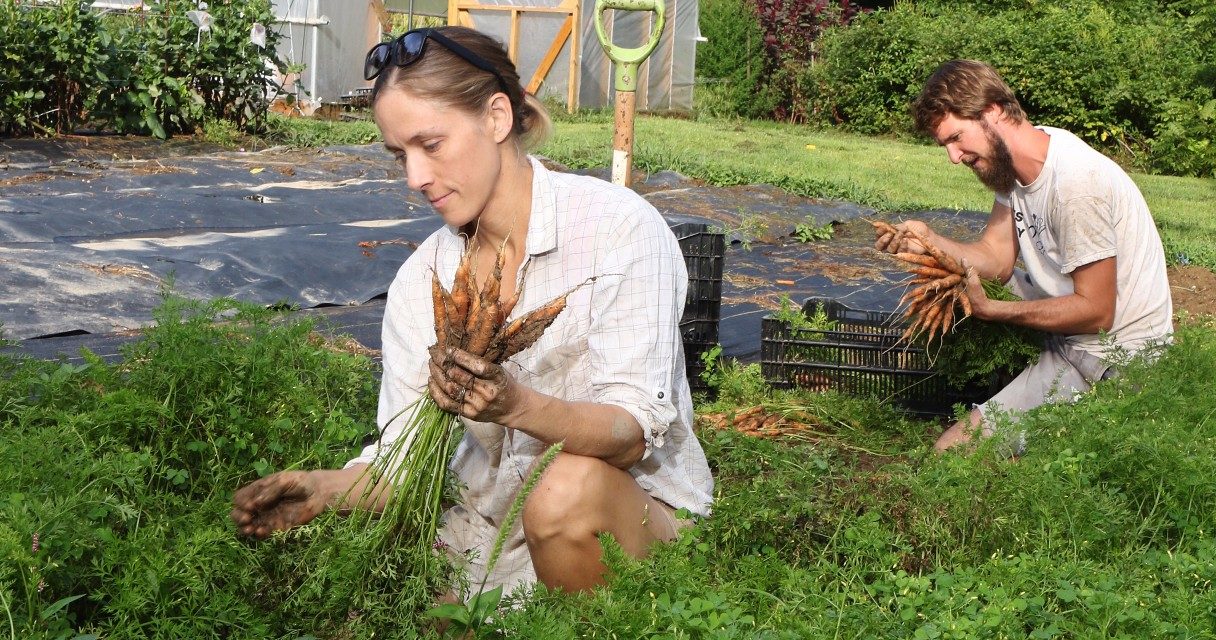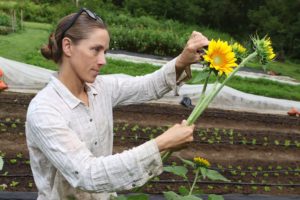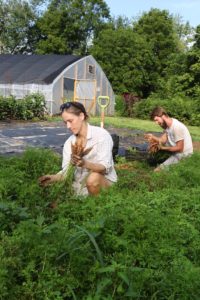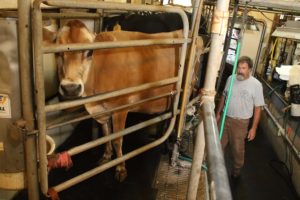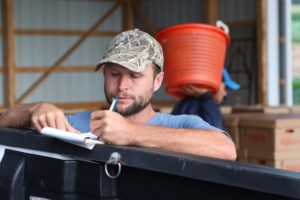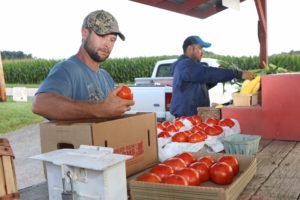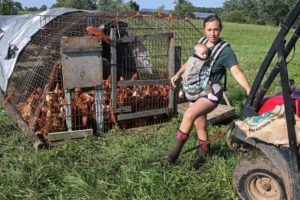
Katelin Brower with her daughter Carmella, 5 months, moves the portable coop for her free range egg laying chickens, at the Whispering Breeze Farm in Taneytown.
by James Rada, Jr., photography by Bill Ryan
Katelin Brower’s workday starts at 4 a.m. While her daily commute is a short one from the house to the barns at Whispering Breeze Farm in Taneytown, she will only be able to stop back in for lunch. Her day doesn’t end typically until 7:30 p.m. or 8 p.m. During that 16-hour day, she is busy milking cows, feeding livestock, working with customers, and dealing with the never-ending list of things that need doing on a farm.
“I love the animals and find it rewarding,” says Brower, who works the farm with her husband and in-laws. “It’s a privilege and honor to know your hard work is going to feed hundreds of people.”
Agriculture is big business in Carroll County, but it’s a big business driven by small farming operations.
According to the Maryland Food System Profile collected by Johns Hopkins University, the value of Carroll County’s agriculture products in 2012 (the most recent data available) was $111,637,000. All of these products were produced by 1,092 farms, of which 895 sell $50,000 or less in a year.
“Our big three areas of agriculture in the county are dairy, commodities and forage, and beef cattle,” says Diana Hare, Agriculture Development Specialist with Carroll County Economic Development.
“We also have two sleeping giants, which are nurseries and horses.”
The Land
Farms in the county range from operations like Two Boots Farm in Hampstead, which has about an acre of land that is tilled and a half-acre of orchards to large operations like Lippy Brothers in Hampstead, that farm 10,000 acres.
Carroll County had 132,630 acres of farmland in 2012. This was a significant drop from just a few years earlier when it had more than 160,000 acres. “Some farmers retire and sell their farms to have money in retirement,” says Hare. “Farmers who are struggling find it easier to sell, too.”
The same reason that makes it attractive to sell a farm also makes it hard for farms to grow or new farmers to start an operation. Land costs a lot. Greg Horner with Deep Run Farms in Hampstead bought a small farm a few years ago that cost him nearly $10,000 an acre.
“The only way that I could make the numbers work was to put the farm into farmland preservation,” Horner says.
State and county farmland preservation programs pay the farmer for easements on the property that ensure that the property can only be used for agricultural purposes. Carroll County has around 70,000 of preserved farmland.
“It definitely helps farmers stay in farming,” Hare says.
In some cases, farmers will rent farmland. Lippy Brothers rent 80 percent of the acreage that it farms.
“Renting acreage can be tough on smaller farmers because the larger farms can afford to pay more land rent,” says Horner.
Two Boots Farm is just a small one-person operation run by Elisa Lane, but even she felt the expense of purchasing the land. “Farming is really difficult to get into, and farmers aren’t getting rich doing it,” she says.
Running A Farm
Operating a farm is an investment, some might even say a gamble. Farmers not only invest in the land but also everything needed to raise goods. This might include buying structures, equipment, livestock, and seed. Then there are things like insurance and maintenance.
“We are constantly upgrading with the best technology that we can afford, but you have to pay for the upkeep. Things wear out,” says Brower.
Once farmers make all these investments, they have to hope that they get a good yield and that their products are priced well so that they sell. Horner says that he projects what his yields will be based on historical trends. The commodities market often determines what he can sell his crops for wholesale, but for his retail operations, he has more leeway in setting prices.
“I try to set a price that I can make money at, and then try to hold it for the season,” Horner said.
Crop prices can often fluctuate during the year. For instance, Horner said that when he was interviewed for this article, his squash prices were considered extremely cheap, but a month earlier that same price was considered expensive.
When all is said and done, though, most farmers would agree, they don’t make a lot, especially if it’s broken down to an hourly rate.
“You bust your butt all year long working to pay the bills, and then there’s just a little bit left over for you,” says Horner.
What can be worse is when a farmer loses a crop to drought, storm, or even animals foraging. Horner says that he has had a hurricane come through the area that laid his sweet corn field flat to the ground.
“You feel sick to your stomach,” he says. “You watch something you had worked hard at hoping would make you some money, destroyed by Mother Nature.”
At times like that, farmers are grateful for their crop insurance even though it’s another added expense with which they have to deal.
Community Supported Agriculture
Many farms are becoming part of the Community Supported Agriculture (CSA) movement. The concept has been around for a quarter century, but it has become a popular way for smaller farms to maintain their viability. Through CSA’s, people pay a farmer up front for a season’s worth of produce a week at a time. It is sort of like buying a share of the farm with the crops being the dividend.
“The farmer gets cash at the beginning of the season when they are cash-poor, and the customer gets a season’s worth of produce,” says Elisa Lane with Two Boots Farm.
Deep Run Farms is also another local farm that offers Community Supported Agriculture.
A Way of Life
Farming is not a job, as any farmer will tell you. It’s a way of life. Many farmers are born into the life. Horner is a fifth-generation farmer. The Browers are also a multi-generational farming family.
Lane, on the other hand, is one of the younger farmers that field of agriculture needs to attract. She got into farming because she has always been interested in self-sufficiency and growing food interested her. She has also learned that farming is a lifestyle.
Because the dairy cows at Whispering Breeze Farm need to be milked daily, Brower said she and her husband don’t get to take vacations. “We only get every other Sunday off, so we try to take a day trip once a month to somewhere,” she says.
Asked why he keeps at something that takes over his life with not a huge return, Horner explained it this way: “You lose money for two years in a row, and you wonder why you do it. Then you have a year when you make money, and you think, ‘I can do this.’ Then the next year you only break even, and you lose money the next year. You think about giving up, and then you have a good year, and everything repeats.”
The Future
While there will always be farming in Carroll County, how it is performed is changing. The average age of the county farmer, for example, is 58, so it takes a little more ingenuity to attract new farmers like Lane into the life.
“You’re going to see a shift from commodity farming to niche farming,” says Hare. “It’s already starting to happen with the wineries, breweries, and agritourism growing in the county.”
She says that in a generation, you’ll be hard-pressed to find a farm in the county that specializes in one thing. Farms are diversifying to reduce their risks.
Meanwhile, before the sun rises tomorrow, hundreds of Carroll County’s farmers will be at work long before most residents stir from their beds.

